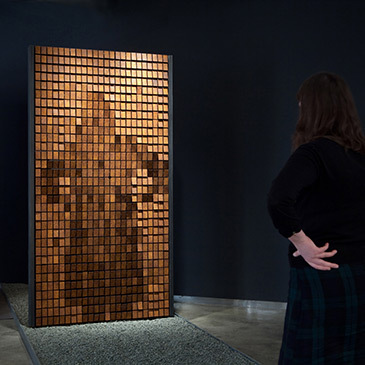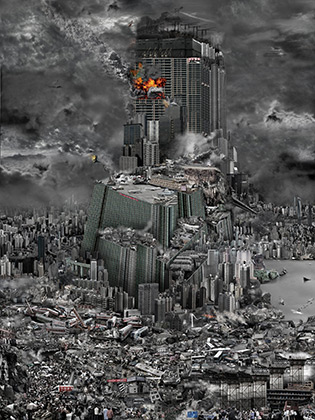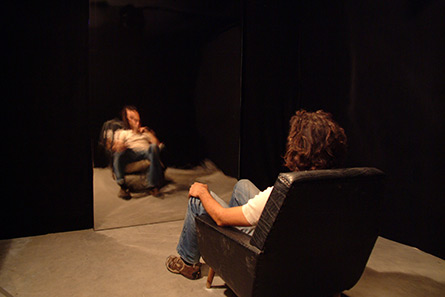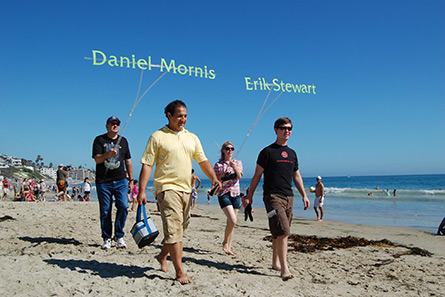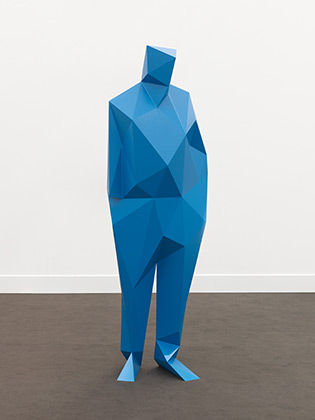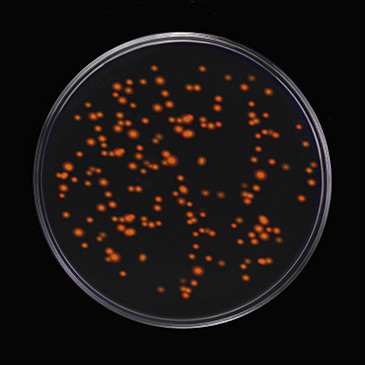DIGITAL PRACTICES OF CONTEMPORARY ART
by Dominique Moulon [ May 2013 ]
Like every other sphere, digital technologies and networks are invading the visual arts. After taking on board photography and video, how are artists responding to this new medium?

Right in line
Jan Robert Leegte,
Blue Monochrome.com, 2008.
 G
Go to bluemonochrome.com and you will see a blue rectangle the saturation and texture of which evoke International Klein Blue. Click on the tiny Google logo at the bottom left and you call up the Maps app, and it dawns on you that the surface of pure color so similar to the IKB that Klein patented in France in 1960 (Soleau envelope no 63 471, deposited at the Institut National de la Propriété Industrielle), is in fact just a fragment of Pacific Ocean background. A readymade of sorts. In 2008
Jan Robert Leegte reserved the address IP 64.90.48.70 with the Internet Corporation for Assigned Names and Numbers in order to use it as his blue monochrome. Artists have always appropriated contemporary technologies, and there are plenty of examples using the Internet. Leegte does so in order to continue the tradition of the monochrome, but that’s not the kind of thing collectors are going to want to pay for it. In art the immaterial is value only if it is material.
Daniel Rozin,
Rust Mirror, 2009,
courtesy Bitforms Gallery.
 M
Many digital works are about rereading or reactivating historical themes or tendencies. This is especially true of the series of mechanical mirrors by American artist
Daniel Rozin. The first, Wooden Mirror, was conceived in the late 1990s and made, as its name indicates, of wood. The 2009 Rust Mirror comprises 768 rust-colored tiles. The chief characteristic of these Mechanical Mirrors is that they are made of non-reflective materials (wood’s reflectivity index is about the same as for rust), yet they still reflect viewers because their motorized parts are digitally controlled and act as pixels to recompose bits of reality by capturing the different aspects of the light. The representation and use of mirrors is common enough in art, but for Rozin the art consists in using non-reflective materials to make reflective surfaces. If only via the title. Again, these are works which continue the tradition by reactivating historical practices. Extremely complex, and offering few guarantees as to longevity, such works nevertheless have access to the market via the Bitforms gallery in New York, which specializes in digital art.

Global village
Du Zhenjun,
The Tower of Babel: the Accident,
2010, courtesy Galerie RX.
 O
Of course, there’s no denying that, thanks to digital technologies and, above all, networks, we have well and truly arrived in the global village prophesied by Marshall McLuhan back in the 1960s, in the age of the first long-distance computer connections. Our perspective has changed accordingly, and so has the view taken by artists, whether their work is digitally based or not. The photograph The Tower of Babel: the Accident (2010) by
Du Zhenjun reflects this in its subject, form and means of production. Here, “accident” seems to be universal, like the form announced by Paul Virilio, contributing to speed as progress. It is indeed about the simultaneous catastrophe of all means of transport, the catastrophe that would shake every building in Du Zhenjun’s world-city. His city is planetary because it is a sum, a collage of monuments gleaned from global Internet. Before the artist put them together, the only thing these images had in common was the fact of being indexed as “tower” or “building” on the Web. One can imagine the artist going from server to server to collect the precious materials for his gestating global constructions.
Julien Levesque,
Street Views Patchwork,
2009.
 T
There was a time when photographers were commissioned by states to travel the country and inventory its buildings and territories. Since 2007, Google Street View cars have been scouring the world and in the process building up the biggest photographic data base all time. There are artists of ubiquity who, like Julien Levesque, revisit the world. Its Street Views Patchwork (2009) is wholly automatic. The four horizontal bands, which recompose a global landscape, mix multiple temporalities. Utah neighbors Brittany, Finland is with Japan, and yet resulting landscapes are plausible. There is even an air of déjà vu about them. This clever appropriation by the French artist places us simultaneously in yesterday and today, here and there. Wherever it is shown on the planet, this landscape is shared one. Also, we often find ourselves visiting simultaneously the same places that appear to us as deserted in our browser. Unsheltered, as were the ideal cities once commissioned by humanists with a thirst for utopias. By exhibiting Street Views Patchwork,
Julien Levesque turns museum spaces into so many studioli in which we contemplate the aleatory flux of the sum of all known worlds, or nearly, because we need to omit nearly all of Africa, of which Google knows only museums, and also China.

Societal problematics
Samuel Bianchini,
All Over, 2009,
 B
But artists who, like
Samuel Bianchini, draw on the technologies of the day, also focus on contemporary issues. The world of finance is the subject of Bianchini’s All Over (2009). Frontal, when accessed on-line, when exhibited it comprises several screens, as in market rooms. The representation of the images that follow on there refers to ASCII Art from the origins of computing, when programmers used to draw, replacing shades of grey with typographic characters. The photographs evoking the world of those who, with a word of gesture, sell or buy, are thus constituted only by figures accompanied by a few symbols for the dollar, the euro, the pound sterling or the yen. But the characters in these graphic representations are renewed to the rhythm of the fluxes of the global economy which is written out between New York and Paris, between London and Shanghai. The outstretched hand of the trader seems to be made fragile by the exchanges which take place at speeds that defeat human understanding. This is the speed of machines linked up to the Internet backbones, the one feared by Paul Virilio. For traders have gradually yielded to algorithms which exempt their users from responsibility.
HeHe, Nuage Vert,
Ivry-sur-Seine, 2010.
 T
There is no field, be it art, finance or even ecology, which has not been profoundly changed by the digitalization of the world (not that world has become virtual in any way). A simple question put to a search engine means bringing into play a power station or dam, via gigantic data centers. Cloud computing, as we know, is a mere trick. The
HeHe collective uses artificially produced, whitish clouds to question the way we live. Since 2008, Helen Evans and Heiko Hansen have been redrawing the clouds of our consumption, slowly drifting up from the tall chimneys that long since ceased to symbolize progress. Equipped with green lasers, they add sublimity to their contours (when local authorities allow it). In 2010, indeed, they defied the prefecture of Seine-et-Marne, which had forbidden them to artistically color the vapor emitted by the waste burning plant of Ivry-sur-Seine. The sub-prefect’s letter on this subject is indeed an integral part of the documentation of their urban performance titled Green Cloud. Just as the Soleau envelope is a component of International Klein Blue. As for the use of pure color by Helen and Heiko, it more generally exemplifies the way artists use technology to enter the political sphere and focus on societal questions.

Relational form
Lawrence Malstaf,
Mirror, 2002,
courtesy
Galerie Fortlaan 17.
 I
If there is a field whose profound mutation is simply the consequence of increased digit presence, it is that of relation: our relation to ourselves, if we consider the multiplication of applications dedicated to the management of our personal image, and our relation to the other, regarding our capacity to construct new friendships on the social networks. In
Lawrence Malstaf’s installation Mirror (2002), the visitor activates the work by pressing a red button of the kind that equips machine tools considered dangerous. This causes their reflection to metamorphose to the rhythm of the mirror’s internal movements. The presence of the viewer, who in fact is sitting comfortably in an armchair, changes increasingly as the movements of the apparatus accelerate. To the extent that, at the end of the experience, the armchair is perceived as mystifyingly empty by the very person who thought they were sitting in it. The use of technologies, especially when they are not visible, authorizes every kind of illusion. As for the experience of the mirror “prepared” by Lawrence Maltstaf, it belongs in the realm of the intimate, going so far as question the very presence of the person who takes it on, in a society where self-image is at the center of so many economic models.
Aram Bartholl, WoW,
2009, Laguna Art Museum.
 A
As an artist,
Aram Bartholl is more concerned with collective experience. His urban performance WoW illustrates Nicolas Bourriaud’s idea of relational aesthetics. Inspired by the massive multi-player game World of Warcraft, it also came out of the participative workshop that took place at the Laguna Art Museum in 2009. The workshop can be an economical interesting model when it enables artists whose works are not adapted to the market to produce in spite of it all. At Laguna Beach, California, the German artist started by evoking the way in which avatars are given their user name in the World of Warcraft. Participants then get down to work cutting out the typographic characters of their given and family names, then putting them on long stick. The performance consists in walking around the coastal city carrying one’s name above one’s head, as is done in 3D online games. The only difference being that one depends on the carrier of one’s own identity. Online, the identity is interchangeable, whereas in reality it proves complicated to change. The relation between the virtual and the real is a recurrent question in the work of Aram Bartholl. And who is better equipped than a digital artist to problematize a 2.0 identity, especially when this uses only bits of cardboard and pairs of scissors?

Beyond the digital
Xavier Veilhan,
Richard Rogers, 2009,
coll. Aldo Bensadoun,
© Guillaume Ziccarelli.
 T
The technologies that we once described as new are constantly moving on, surprising us with the emergence of innovative tools and services that artists will continue to appropriate. But the time of discovery, at the era of the first generation of digital natives, is behind us. We have entered the phase “after” fascination. Here we no longer distinguish between what is entirely digital and what is only partially so, or not at all, or not yet. The degree of detail in
Xavier Veilha’s The Architects series (2009) varies from one statue to another. Going from the extreme realism inherent in three-dimensional scanning to the evocation of old-school video games. Polygons had only just disappeared from our games consoles when they reappeared in the sculptures of artists like Xavier Veilhan or in the architectural constructions of Jacob & MacFarlane. In order to capture the contours of his architects, Veilhan, asked them to hold their pose as one does when sitting for a painter, but only to allow the machines the time to do their work. Of course, as weariness sets in the postures become more relaxed or natural. Few polygons are used to represent Richard Rogers, but this is because posture is more important than detail. These polygonal sculptures encourage viewers to step back. For only at a distance can we recognize the corporal signatures of the sitters. The artist himself is amazed at this capacity for recognition at a distance.
Eduardo Kac,
Cypher, 2009.
 F
Finally, and going beyond the digital, there are bio- and nano- technologies, which also result from calculating power of machines. But such scientific progress is valuable only if we make it our own. That is what
Eduardo Kac encourages us to do with his transgenic kit, Cypher (2009). Inspired by DIY culture, this work is articulated around synthetic DNA, which encodes a poem that the reader must “reveal” by following a scientific protocol written by the artist himself. The poem included in this piece refers to the film Welcome to Gattaca, which is about the desire for genetic perfection, something we all need to reject and fight. “A tagged cat will attack Gattaca”, says the author through the kit, implying our role as spectators of progress, which is what we will remain if we do not become more active. As for nanotechnologies, they become part of our everyday life even before we identify them. This is when Kac offers an aesthetic experience of the same in Aromapoetry (2011), a book whose molecules are literally “booby-trapped” at a nanometric level. For, as in past, here is no scientific or technological advance that cannot be made into art. Whatever its nature.
Translation, Charles Penwarden

Written by Dominique Moulon for Artpress and translated by Charles Penwarden, May 2013.

